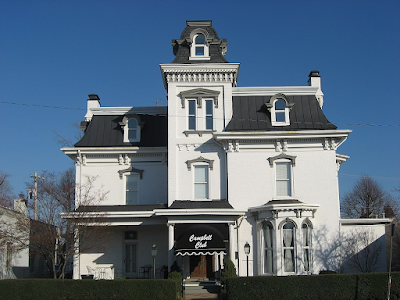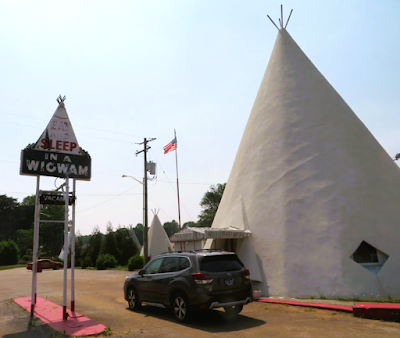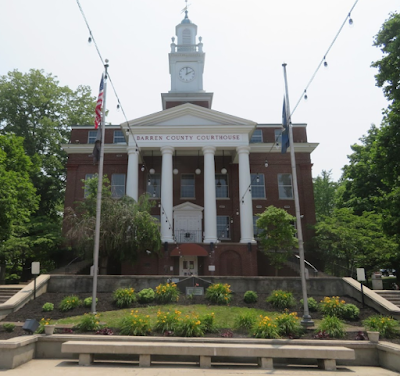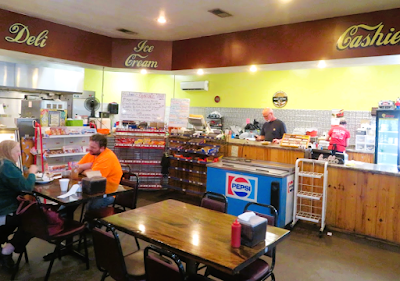After our rather unsatisfying and disappointing BBQ dinner, we wandered around the center of Owensboro to take photos and explore.
This is
the former Carnegie Free Public Library.
This Beaux-Arts structure was built in 1909. In 1903, the Owensboro Business Men’s
Association had solicited at $30,000 donation from Andrew Carnegie for a
library building. For a time, Carnegie
was the richest man in the world. In any
case, city budgeted funds were added to public contributions to buy the lot and
plan for construction of the building.
In 1968
the library was moved to a larger building and this structure became the home
of Owensboro’s “Area Museum” in 1968. In
1977 that museum moved to another facility and the former library building
became the home of the Museum of Fine Art.
I took a
virtual tour of the Art Museum and it appears to be quite a collection of an
eclectic and quality grouping of art forms.
One display includes 16 large stained glass church windows from the late
1800s. To learn more, go to Owensboro Museum of Fine Art – Owensboro, Kentucky (omfa.us).
Another
building of note in Owensboro is the three-story Federal Building and U.S. Post
Office. The structure is the finest
example of Beaux-Arts architecture in the city.
It also is the more architecturally significant civic building.
Notes:
· Owensboro has been the home of many sports
stars and celebrities. The Hayden family
provided 3 racing professionals and the Green Family did the same for
NASCAR. As regards the latter
organization, both Michael and Darrell Waltrip are from Owensboro. The best known celebrities from town were Tom
Ewell, Florence Henderson and Johnny Depp.
· As of the most recent census data, the
Owensboro metropolitan area has about 117,000 residents.
· FYI, Owensboro is the home of the Bluegrass
Hall of Fame and Museum. You can learn
all about it at Home - Bluegrass
Music Hall of Fame & Museum (bluegrasshall.org).
I
couldn’t find any historical reference to this building or buildings in downtown
Owensboro. However I’d be really
surprised if this handsome and eye-catching structure wasn’t part of one of the
city’s commercial districts that are listed in the National Register of
Historic Places. Unfortunately, the data
bank at the National Register is incomplete for the great majority of the
historic structures in the city. The
Register includes 34 listings for Owensboro included 4 Historic Districts, each
containing a number of buildings or historic places.
Currently,
the row of store fronts in this old building has 3 businesses in place. Riverwalk Razor Barber Shop; Hooded Crow
Tatoo Shop and; Vintage Stripes Barber Academy.
I’m guessing that they are all related…
Note:
· Unfortunately, the history of Owensboro was
severely blemished in August of 1936.
That’s when the downtown area became the site of the last public hanging
in the USA. A 26 year old African
American man was convicted and sentenced for the rape and murder of a 70 year
old woman. Only 37 days lapsed between
the crime and the execution. A carnival
atmosphere was in place on the day the accused man, Rainey Bethea, was
hung. There were food vendors, as well
as a large crowd including children and reporters. Worse yet, before Bethea was dead, the crowd
began to tear at his clothes and even his body for souvenirs. Following this sad and embarrassing fiasco,
the Kentucky General Assembly quickly abolished public executions.
We both
loved the look of this narrow three-story Romanesque Revival building. The Breidenbach building, completed in 1890,
remains one of the best examples of this style of architecture in Owensboro’s
downtown commercial area. The structure
was part of what was then called “Court Row” and it was constructed by Edward
H. Breidenbach, the Light and Water Superintendent for the city for over 50
years. Breidenbach was also a distiller,
city commissioner and an extensive land owner.
In recent times, the building served as a law office but now it is the
headquarters for MediaWorks Advertising, a company that has been in business
since 1996
This is
the old Odd Fellows Building. This eclectic
Beaux Arts and Italian Renaissance three-story structure was built in
1895 but unfortunately, part of the street level portion has been poorly altered. The Odd Fellows chapter had 125
members in 1895 when the building was completed. The Odd Fellows Lodge was on the third floor,
while the rest of the building was commercial, the second floor serving as
office space and the first floor as retail space.
The Lodge
was organized in 1856 and it owned half of the “Court Row” block at the time
they built this structure. I noted that
this 22,255 sq. ft. building was sold at auction in May of 2022. It cost $610,000. Currently, the building is the home to a
restaurant, Colby’s Fine Foods and Spirits.
If you’re interested, you can learn more about this restaurant at http://www.colbysfinefoodandspirits.com/.
I
couldn’t find out anything about this juxtaposition of what I’m sure is at part
of an historical structure and a modern glass addition. It was an interesting and eye-catching
concept which preserved the front of an impressive old building while serving
the needs of the Truest Bank Corporation.
A similar and more dramatic mix of old and new was created a number of
years ago in Paris France with the expansion of the Louvre.
N0tes:
· The first European who settled at Owensboro
was frontiersman William “Bill” Smeathers in 1797. A restless soul, he moved around quite a bit,
ending up in Texas. He fought in The War
of 1812 and in the Texas Revolution. In
1909, when living in Kentucky, using the name “Bill Smothers”, he was tried for
the murder of a man who allegedly raped his sister. He was acquitted but advised to leave the
area for a while. For more on Bill
Smeathers, go to https://en.wikipedia.org/wiki/William_Smeathers.
· The settlement that was to become Owensboro
was originally known as “Yellow Banks” after the color of the land beside the
Ohio River. In 1817, the town was
renamed “Owensborough”, after Colonel Abraham Owen. Owen served as a colonel and as aide-de-camp
to William Henry Harrison at the Battle of Tippecanoe, where he was killed in
1811.
· Owensboro was incorporated in 1817 and during
the 1800s it developed as a market for tobacco and a center for distilling
bourbon whiskey. By 1900, the city could
count 12 active distilleries and 25 tobacco stemmeries. FYI, a stemmery is a building where tobacco
leaves are stripped for the production of tobacco products.
The Beaux
Arts style Callas Sweet Shop was built in 1921.
The National Register of Historic Places termed it ‘elegant’ and
described it: “The buff color terra cotta and tile decorative elements, such as
brackets, shields, and cornices, create a simple, classical appearance”.
Listed in
the National Register in 1986, the building was deemed significant as “having
the only surviving example of complete terracotta tile fronts in downtown
Owensboro. The original owner was a
European immigrant who started out shining shoes. His first shop was called Progress
Candy. He built this shop next door to
the Empress Theater. When Callas’ health
failed he rented it to a local who added sandwiches to the menu. For many years, a visit to the Callas Sweet
Shop was an Owensboro tradition…
More
recently, for several years this building served as “Bill’s Restaurant”. Today, it is once again a restaurant. Now it is called “Sassafras”. See Sassafras (sassafrasowensboro.com).
This is
the old Trinity Episcopal Church in the 400 block of West 5th Street
in Owensboro. Listed on the National
Register since 1972, this building was built way back in 1875. In 2 years it will be 150 years old… The
structure has the attractive straightforward lines of typical village Gothic
Chapels that are found across the English countryside. It is the oldest brick church building in
town…
The
church was first organized in the Masonic Lodge with services being held over
Dr. McGill’s Drug Store. A bit later,
church members bought a carpenter’s shop and worshipped there until this building
was completed. Trinity Episcopal Church
would seat 600 people and many people thought that it was too large for the
city.
Owensboro
acquired the Old Trinity Centre/Church in 1972 and it was offered to the
Theater Workshop of Owensboro in 1973.
For many years, theater productions were staged here but in the 1990s,
play productions were moved to the new RiverPark Center. In 1999, a major renovation of Trinity Centre
was completed and productions are once again being staged in its intimate
auditorium. You can learn more about the
Theater Workshop of Owensboro at Theatre Workshop of Owensboro | The Longest Running Show in
Town.
This big
blue Queen Anne style home caught our eye.
The James J. Sweeney House was built in 1893. The home ranks among the finest examples of
late nineteenth century domestic architecture in Owensboro. James Sweeney was a prominent local attorney
who was a partner in the law firm with his father and a brother. The home served as a residence for over 70
years. The five bedroom and five bath
home has 8,580 sq. ft. of space.
In the
1970s the Sweeney home was converted into a restaurant. But in 1980, it was sold to owners who
rehabilitated it for use as a private residence once more. The current on-line estimated value for this
property is $658,100.
I
borrowed this old photo from the internet as this old home was being rehabilitated/updated
when we stopped by. Scaffolding doesn’t
make for a great photo. This home,
referred to as the Gillim House, was built ca. 1880 by John Woolfolk, a local
business entrepreneur. A few years later,
he sold it to C.D. Jackson, a relative of President Andrew Jackson and a major
local landholder. When Jackson died, his
heirs sold it to a wealthy distiller who, a few years later sold it to J.D.
Powers, an attorney and state legislator.
Finally, it was purchased by Dr. W.F. Gillim who owned it for 31 years…hence
its known as the Gillim House.
The home
became a boarding house for the upper class in the 1930s. In 1959, it was converted to a private members
only dining club, hence the photo showing it as the Campbell Club. Once again, it has changed hands. Small world… Bill Hughes, the former chef and
general manager of the Campbell Club and the former owner/operator of Bill’s
Restaurant in the Callas Sweet Shop location has moved on. The Gillim House will now be known as the
Cupola Club and that same Bill Hughes is the proprietor. I’d provide the contact information but this
is a members’ only dining opportunity...
Just
click on any of the photos to enlarge them…
Thanks
for stopping by for a visit!
Take
Care, Big Daddy Dave











































